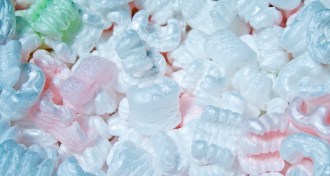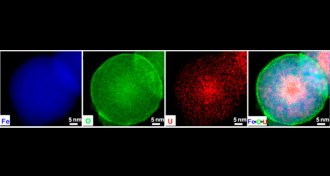Chemistry
Sign up for our newsletter
We summarize the week's scientific breakthroughs every Thursday.
-
 Chemistry
ChemistryShipwrecked bubbly gives chemists a taste of the past
Champagne preserved at the bottom of the Baltic Sea for 170 years has given chemists a glimpse of past winemaking methods.
By Beth Mole -
 Chemistry
ChemistryNew data on synthetic element trigger rethink of periodic table
New data on lawrencium, element 103, trigger rethink of periodic table.
By Beth Mole -
 Environment
EnvironmentOil from BP spill probably sprayed out in tiny drops
Oil that gushed from the well in the 2010 Deepwater Horizon spill may have shattered into tiny droplets, with high pressures doing the work of dispersants.
By Beth Mole -
 Anthropology
AnthropologyKennewick Man’s bones reveal his diet
Pacific Northwest man who lived 9,000 years ago ate from an almost entirely seafood menu, a new analysis finds.
By Bruce Bower -
 Chemistry
ChemistryIdea for new battery material isn’t nuts
Baking foam peanuts at high heat can form wee structures that lure lithium ions and could make for cheaper, more powerful batteries.
By Beth Mole -
 Chemistry
ChemistryAir pollution molecules make key immune protein go haywire
Reactive molecules in air pollution derail immune responses in the lung and can trigger life-long asthma.
By Beth Mole -
 Chemistry
ChemistryToday’s pot is more potent, less therapeutic
The medicinal qualities of marijuana may be up in smoke thanks to years of cross-breeding plants for a better buzz.
By Beth Mole -
 Chemistry
ChemistryNew method leaves older ways of 3-D printing in its goopy wake
Finding the sweet spot in a pool of resin, chemists can create detailed 3-D objects faster than 3-D printers.
By Beth Mole -
 Chemistry
ChemistryCooking up life’s ingredients, all in one pot
An interconnected series of chemical reactions with a few primordial chemicals can cook up all the necessary elements of life
By Beth Mole -
 Anthropology
AnthropologyPeople moved into rainforests much earlier than thought
People lived year-round in rainforests well before previous estimates, an analysis of teeth excavated in Sri Lanka suggests.
By Bruce Bower -
 Chemistry
ChemistryIron nanoparticles snatch uranium
With a dash of iron nanoparticles and a magnet, researchers can quickly harvest radioactive fuel.
By Beth Mole -
 Chemistry
ChemistryBrute-force chemistry study retracted
The journal Science has retracted a notable 2011 chemistry study in which authors reported a brawny method to break sturdy chemical structures.
By Beth Mole